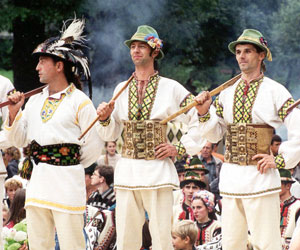- About Ukraine
- Hutsuliya
- Hutsulshchyna
- History and Borders
- The Name and Origin
- Geography and Climate
- The Hutsuls
- Prycarpattia is my Motherland
- Nature and environmental protection
- Kosivshchyna
- Kosiv
- Yavoriv
- Kosmach
- Kuty
- Yabluniv
- Rozhniv
- Rest and Tourism
- Photograph Album
- Library
- Feed
- Store
The name Hutsulshchyna comes from the name of it’s inhabitants. The etymology of this word is unknown. Maybe the most widespread version of it’s origin is in harmony with the word Hutsul — the Romanian word for robber. So the Romanians called their Ukrainian neighbors for the spread opryshkivskyi movement among them.
Some authors transposed the origin of the name Hutsul from the word to stub e. g. кочувати > кочули > гоцули > гуцули. Someone connected it with “Turkic” tribe. Uziv: e. g. узи > уци > уцули > гуцули or with the Turkic word “ulus” — people, state, country.
There is a version, according to which Hutsuls received their name from the Moravian Grand Duke Hetsyla. We have a version similar to this, too, that connects the appearance of the word Hutsul with the personal name Hutsta and the verb “hutsaty”. There are other attempts to explain the birth of this noun. Though it is so far from the truth.

When Hutsuls inhabited the Carpathian slopes is also not exactly known to science. Through the archeological findings there is evidence that the territory, even in ancient times, had some population and elementary culture. Up until the present day there were a lot of findings from the Stone Age. There are numerous constructions here since Roman times. Since Dukes’ times, written documents are almost absent. Though, for example, in Halych-Volyn chronicles, Kolomyiska salt is mentioned, which undoubtedly, was produced near the town of Hutsul salt-works.
As academician, Ivan Krypjakevych, stressed in his work «From the History of Hutsulshchyna», after the decline of Halych State (1340), Hutsulshchyna together with the other neighboring Ukrainian lands, passed to Moldova province; under Poland’s power it passed in 1395. But, during the 14th century, we have no detailed reports from these lands.
Only in the first half of the 15th century, I. Krypjakevych, slowly opens our eyes to a mysterious country to the south of Kolomyja.
There beyond the Prut, new houses, one after the other, appear — are they really new, or are we acquainted with them only for the first time? For the first time we hear about Pechenizhyn and Klychiv, the villages of the Halych and peasant, Ivan Koli. The Rubnytsya Rozhniv River and Rudnyky is mentioned. Here begins real Pokuttya — it’s not the whole Kolomyishchyna, but only a small country in the corner between the Prut and the Cheremosh.
Over the Cheremosh, there are the villages of Rybno and Kuty, on which had privileges from Yahaila some Benish and Indryx, the sons of Zhuhumonta. Between Kuty and Rubno there was a village, Zvyzhyn or Zdvyzhyn that does not exist on the maps today. On the other side of the Cheremosha, are Bukovynski villages, such as Banyliv, Zamoste and Mylijiv. Further on at the foot of the mountains lies Kosiv. At first it was only a village that belonged to the state grounds. The well-known Lithuanian Grand Duke Svydryhailo, who with his brother, Yahailo, ruled in Halychyna on lands given in 1424, to Maxim or Vladovy Drahasynovychevy, maybe Voloshynovy by family.
One monastery is mentioned in Kosiv (today’s village Monastyrske).

